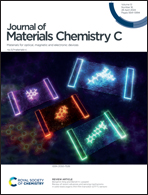Core–shell Si3N4@WS2 porous ceramics with improved electromagnetic wave absorption performance†
Abstract
Ceramic-based absorbing materials have attracted extensive attention in electromagnetic wave (EMW) absorption because they are lightweight and exhibit strong dielectric loss. However, there is still a need for developing the microstructure design of ceramics, and this hinders the further improvement of absorption properties. In this study, core–shell Si3N4@WS2 porous ceramics, with the wave-transmitting phase Si3N4 as the core and the wave-loss phase WS2 as the shell, were prepared using a simple impregnation-hydrothermal method. The core–shell structure provided as large a contact area as possible between WS2 and Si3N4, promoting the formation of heterogeneous interfaces. The as-prepared core–shell Si3N4@WS2 porous ceramics exhibited excellent EMW absorption properties. When thickness was 3.92–4.22 mm, an effective absorption bandwidth of 4.20 GHz was achieved, covering the entire X-band (8.2–12.4 GHz). At a thickness of 4.35 mm, the minimum reflection loss was −65.03 dB. The outstanding EMW absorption performance was attributed to the special core–shell microstructure inducing interfacial polarization loss and optimizing the impedance matching of the material. The findings of this study provide novel insights and feasible strategies for designing ceramic-based absorbing materials with core–shell structures.



 Please wait while we load your content...
Please wait while we load your content...